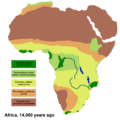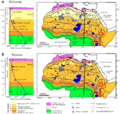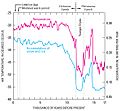African humid period facts for kids
The African humid period (AHP) was a time in Africa's past when the northern part of the continent, including the Sahara desert, was much wetter than it is today. This amazing change happened during the late Pleistocene and Holocene epochs, which are parts of Earth's recent geological history. During this period, the Sahara was covered by green grass, tall trees, and many lakes.
This "Green Sahara" was caused by several things. One main reason was changes in Earth's tilt, which affected how much sunlight different parts of the planet received. These changes made the African monsoon stronger, bringing more rain. Also, more plants and less dust in the Sahara helped to make the monsoon even stronger.
Before this wet period, during the Last Glacial Maximum (a very cold time), the Sahara was a huge, dry desert with many dunes. Big lakes and rivers like Lake Victoria and the White Nile were either dry or very low. The humid period started about 14,600 to 14,500 years ago. Rivers and lakes like Lake Chad grew much larger, and even glaciers on Mount Kilimanjaro expanded. The Sahara desert shrank. There were two short dry spells during this wet period, one called the Younger Dryas and another about 8,200 years ago. The African humid period ended about 6,000 to 5,000 years ago, and the Sahara slowly turned back into a desert.
The AHP allowed many people to settle in the Sahara and Arabian Deserts. It greatly influenced African cultures, even leading to the start of the Ancient Egyptian civilization. People living in the Sahara were hunter-gatherers, and they also started raising animals like cattle, goats, and sheep. They left behind amazing things like the Dufuna canoe (one of the oldest boats ever found) and beautiful rock paintings in places like the Cave of Swimmers. When the wet period ended, people gradually moved away from the drying desert to places with more water, like the Nile Valley and Mesopotamia. There, they helped create some of the world's first complex societies.
Contents
Discovering the Green Sahara
People have wondered about a greener Sahara for a long time. The ancient Greek historian Herodotus wrote about it in 440 BC. But it wasn't until the 1850s that explorer Heinrich Barth seriously thought about past climate changes in the Sahara after finding ancient petroglyphs (rock carvings). Later, in the 1930s, another explorer, László Almásy, came up with the idea of a "Green Sahara" after seeing more rock paintings.
By the late 1900s, scientists found strong proof that the Sahara was once green. They discovered evidence of ancient lakes and signs that the Nile River flowed much more strongly. It became clear that the Holocene period had a long wet phase in the Sahara.
Scientists study the African humid period using different methods. They look at archaeological sites (places where ancient humans lived), old dunes, and deposits left by ancient lakes. They also study pollen from plants and charcoal to understand what the environment was like.
Why the Sahara Became Green
The African humid period happened because the West African Monsoon became much stronger. This was mainly due to changes in how much sunlight Earth received and how the land reflected that sunlight. These changes brought more moisture from the Atlantic Ocean into West Africa.
Earth's Orbit Changes
The main reason for the AHP was an increase in sunlight during the Northern Hemisphere summer. This happened because of a wobble in Earth's axis, called precession. This wobble changes when Earth is closest to the Sun during its elliptical orbit. Between 11,000 and 10,000 years ago, Earth was closest to the Sun during the Northern Hemisphere summer. This increased the amount of sunlight by about 8%, making the African monsoon much stronger and pushing it farther north. From 15,000 to 5,000 years ago, summer sunlight was at least 4% higher than it is today.
When the Northern African land got more sunlight in summer, it heated up more than the ocean. This created a low pressure area that pulled moist air and rain from the Atlantic Ocean. This made the monsoon stronger and allowed it to reach much farther north into what is now the Sahara.
Land and Ocean Effects
Changes in Earth's orbit alone weren't enough to explain the huge lakes that formed in the Sahara. Other factors, like how the land and ocean changed, were also important.
- Less Reflective Land: When more rain fell, more plants grew. Plants absorb more sunlight than bare desert sand. This made the land less reflective (lower albedo) and helped the monsoon get even stronger. Plants also release moisture into the air through evapotranspiration, adding to the humidity.
- Less Dust: A wetter Sahara meant less dust was blown into the air. Large lakes covered areas that are now major dust sources. Less dust in the air means more sunlight reaches the ground, which helps warm the land and strengthen the monsoon. Less dust also affects clouds, making them better at producing rain.
- Ocean Temperatures: The ocean surface temperatures off North Africa also warmed up. This helped move the Intertropical Convergence Zone (ITCZ), a band of clouds and rain, northward. This brought more moisture from the sea to the land.
Other Factors
Many other things also played a role in the AHP:
- Melting Ice Sheets: As large ice sheets in the Northern Hemisphere melted, it affected global climate patterns.
- Mediterranean Sea: A warmer Mediterranean Sea also increased rain in the Sahel region.
- Groundwater: Increased rainfall recharged underground water sources (aquifers), which helped keep plants alive and fed lakes.
- Carbon Dioxide: Higher levels of atmospheric carbon dioxide may have also helped trigger the AHP, especially in tropical areas.
What the Green Sahara Was Like
The African humid period made most of Africa, including the Sahara, much greener. Forests and woodlands grew across the continent. Similar wet periods also happened in other parts of the world, like the Americas, Asia, and the Arabian Peninsula.
Rivers like the Congo, Niger, and Nile flowed much more strongly. Their paths changed, and they carried more water and sediment.
Plants and Animals of the Sahara
During the AHP, the Sahara and Sahel were covered by lakes, rivers, wetlands, and lots of plants, including grass and trees. It was a "Green Sahara" unlike anything we see today. Scientists know this from pollen found in sediments, ancient human sites, and fossils of animals like diatoms, mammals, reptiles, and snails. The vegetation was mostly an open grass savannah with shrubs and trees. In the mountains, moist savannahs grew. Plants that usually grow much farther south today were found across the Sahara. Forests and plants that need a lot of water grew around lakes, rivers, and along the Atlantic coast.
The Sahara wasn't completely green everywhere. Some central and eastern parts were probably drier, and some desert areas remained, though they were smaller.
Many different animals lived in the Sahara during this time. These included antelopes, baboons, catfish, crocodiles, elephants, frogs, gazelles, giraffes, hippos, rhinoceroses, snakes, and turtles. Large herds of animals roamed the Sahara. Some animals spread across the entire desert, while others stayed in places with deep water.
Lakes and Rivers of the Sahara
Many lakes formed or grew larger in the Sahara, especially in the Hoggar and Tibesti Mountains. The biggest was Lake Chad, which became at least ten times its current size, forming a giant lake called Lake Megachad. This huge lake was about 1,000 km long and 600 km wide, covering a large part of the modern Sahara. It even affected the local climate, reducing rainfall in its center and increasing it at its edges. Lake Megachad sometimes overflowed into the Niger River, eventually reaching the Gulf of Guinea.
Other large lakes that might have formed include Lake Megafezzan in Libya and Lake Ptolemy in Sudan. Many smaller lakes also appeared across the Sahara, sometimes forming "freshwater archipelagos" (groups of islands in freshwater). Wetlands also expanded. The Niger River, which was blocked by dunes before the AHP, formed a lake near Timbuktu that later overflowed.
In some areas, temporary lakes formed between sand dunes. These lakes left behind fossils of fish and fertile soils that ancient people later used for agriculture. Even crater lakes formed in volcanic areas, some of which still exist today.
The increased rain also brought ancient river systems back to life. The large Tamanrasset River flowed from the Atlas Mountains and Hoggar westward to the Atlantic Ocean. It was once the 12th largest watershed in the world and formed estuaries and mangroves where it met the sea. Other rivers and wadis (dry riverbeds) also carried water during the AHP. These rivers and lakes likely served as pathways for humans and animals to spread across the Sahara.
Humans of the Sahara
The wet conditions and rich resources of the Green Sahara were perfect for early hunter-gatherers and fishermen. Later, people became pastoralists, raising animals. The human population in the Sahara grew quickly during the AHP.
Scientists have found traces of human activity in places like the Acacus Mountains, where caves and rock shelters were used as camps. At Gobero in the Ténéré desert, a cemetery was found, showing how these ancient people lived. Near Lake Ptolemy in Nubia, humans settled by the lake, using its resources. Many early human tools found are related to fishery, leading some to call this the "aqualithic" culture.
Humans hunted large animals and gathered wild cereals like sorghum. They also started to domesticate cattle, goats, and sheep. Raising animals became very important around 7,000 years ago. The Dufuna canoe, one of the oldest boats, shows that people used boats on the lakes and rivers.
People created amazing rock art in the Sahara, including petroglyphs and rock paintings. These artworks show animals and daily life, like people swimming, which proves the past wet climate. Famous sites include the Cave of Swimmers in Egypt and the Tassili n'Ajjer in Algeria. Humans also made ceramics, and North Africa was one of the first places where pottery was developed, likely because of the increased resources during the AHP.
These ancient people were part of the Epipaleolithic, Mesolithic, and Neolithic periods. They made various stone tools. Genetic evidence suggests that many of these populations came from Sub-Saharan Africa and moved north as the desert became wetter. The AHP also helped some people from Eurasia move into Africa. These good conditions for humans might be linked to ancient myths about paradise, like the Garden of Eden.
The End of the Green Sahara
The African humid period ended about 6,000 to 5,000 years ago. After the plants died off, the Sahara became dry and sandy again. Wind erosion increased, and huge amounts of dust began blowing from the now-dry desert, especially from places like the Bodélé Basin, which is now the largest source of dust on Earth. The lakes dried up, and the green vegetation disappeared. This change from a "Green Sahara" to the dry desert we know today was the biggest environmental shift in northern Africa during the Holocene.
The end of the AHP happened around the same time as a cold period called the Piora Oscillation in the Alps. This period, from 5,600 to 5,000 years ago, saw cooling and changing rainfall around the world.
How the Drying Happened
Scientists are still debating whether the drying happened everywhere at the same time and how quickly it happened. Some evidence from ocean sediments suggests a sudden change, while pollen data sometimes shows a more gradual change. It's likely that the drying happened in steps, from north to south. In some areas closer to the equator, the AHP ended later, between 4,000 and 2,500 years ago.
The drying was mainly caused by the same orbital changes that started the AHP, but in reverse. As summer sunlight in the Northern Hemisphere decreased, the monsoon weakened. As rain decreased, so did the vegetation. Less vegetation meant the land became more reflective (higher albedo), which further reduced rainfall, creating a cycle that led to desertification.
Impact on Humans
As the Sahara dried, fewer people lived there. Human populations in Northern Africa decreased between 6,300 and 5,200 years ago. Many settlements in Arabia were abandoned around 5,300 years ago. Some people who lived in the desert for longer survived by using underground water.
People adapted to the drying climate in different ways. In the Central Sahara, people shifted from hunting and gathering to raising animals, and many became more nomadic, moving around to find water and pasture. They also started raising more sheep and goats, which are better suited for dry climates, and this change is seen in their rock art.
The drying climate forced people and animals to move to areas with more water. Many people moved to the Nile River valley. These "climate refugees" helped create the Ancient Egyptian civilization, with its pharaohs and pyramids. Similar movements led to the development of other great civilizations along rivers like the Euphrates, Tigris, and Indus.
The drying of the Nile River around 4,160 years ago may even be linked to the collapse of the Old Kingdom in Egypt. The end of the AHP also affected other ancient civilizations, like the Akkadian Empire in Mesopotamia.
In Central Africa, forests became smaller, and savannahs grew, which helped the Bantu-speaking populations spread. The slower drying in some areas gave humans more time to adapt to the changing climate.
Impact on Nature
In the Sahara, animal and plant populations became separated and were limited to small, moist areas, like mountain ranges. Fish and crocodiles, for example, now only live in isolated water bodies. Some Mediterranean plants and reptiles also became stranded in the mountains as the desert grew around them.
The drying of the African Great Lakes region split gorilla populations into western and eastern groups. Other animal species were also affected, with some aquatic species disappearing from the Sahara entirely. The drying climate, along with human activities, may have led to the extinction of some large mammals in Egypt.
The drying of the Sahara also had a global impact. The shrinking of wetlands led to a drop in atmospheric methane levels. And as the Sahara became a desert, the amount of dust blowing from Africa increased dramatically. This dust can travel across oceans and affect climate and ecosystems far away, even helping the Amazon rainforest grow.
The Sahara Today
Today, the African Monsoon still brings rain to parts of Africa, mainly between 5° south and 25° north latitude. The areas around 10° north get most of their rain from the monsoon in summer. Farther north, the Sahara desert receives very little rain, often less than 50-100 mm per year.
The Sahel region, which borders the Sahara, experienced severe droughts in the 1970s and 1980s, where rainfall dropped by 30%. However, rainfall has increased since then, and the Sahel is becoming greener.
What About Future Global Warming?
Some scientific models suggest that global warming and increased carbon dioxide could lead to more rain in the Sahel and Sahara. This might cause plants to grow in areas that are currently desert, making the Sahara a bit greener again. However, this greening would likely not be as widespread as during the African humid period.
More rain in the Sahara could also mean less dust blowing from North Africa. This could affect hurricane activity in the Atlantic Ocean, potentially increasing the threat of hurricanes hitting the Caribbean and the East Coast of the USA.
Scientists are still studying how human-caused climate change will affect the Sahara. The changes are happening differently than the natural changes that caused the AHP. While a greener Sahara could allow agriculture to expand, more rain could also lead to more water borne diseases and flooding. Understanding the African humid period helps scientists predict what might happen to the Sahara in the future.
See Also
Images for kids
-
Vegetation and water bodies in the Eemian (bottom) and Holocene (top)
-
Lake Megachad, with present-day Lake Chad highlighted in green












